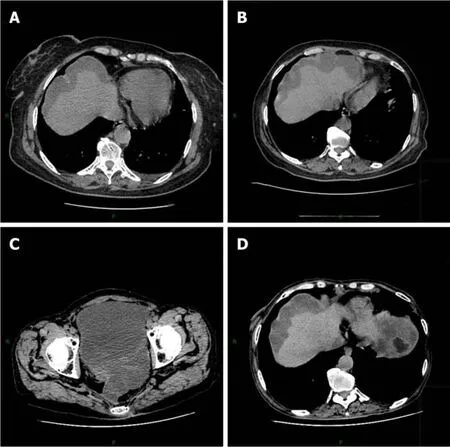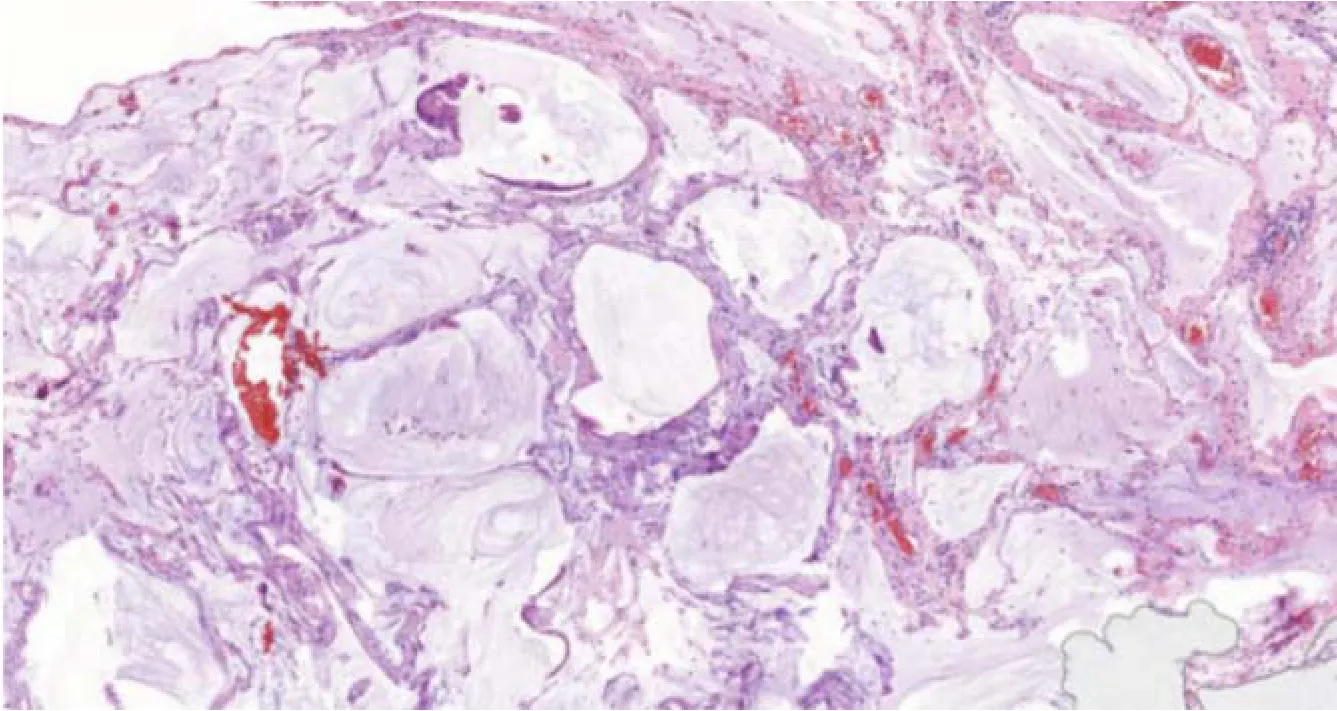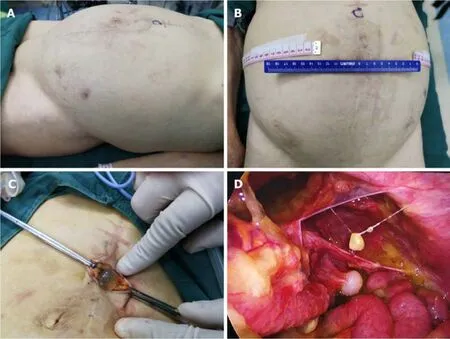Apatinib for treatment of a pseudomyxoma peritonei patient after surgical treatment and hyperthermic intraperitoneal chemotherapy:A case report
2019-04-22RongHuangXiuLingShiYunFeiWangFeiYangTingTaoWangCunXuPeng
Rong Huang, Xiu-Ling Shi, Yun-Fei Wang, Fei Yang, Ting-Tao Wang, Cun-Xu Peng
Rong Huang, Fei Yang, Department of Clinical Medicine, Jining Medical University, Jining 272000, Shandong Province, China
Xiu-Ling Shi, Yun-Fei Wang, Ting-Tao Wang, Cun-Xu Peng, Department of Gynecology, The Affiliated Hospital of Jining Medical University, Jining Medical University, Jining 272000,Shandong Province, China
Abstract
Key words: Pseudomyxoma peritonei; Abdominal distention; Anti-angiogenic agent;Apatini; Case report
INTRODUCTION
Pseudomyxoma peritonei (PMP) is a rare disease with an estimated incidence of 1 per million per year, and the appendix and ovaries are reported as the primary sites[1].Surgical resection is the preferred and most effective treatment.However, according to Sugarbaker[2], the recurrence rate after tumor reduction can be as high as 100%.After aggressive cytoreductive surgery (CRS) and hyperthermic intraperitoneal chemotherapy (HIPEC), patient outcomes remain unsatisfactory due to recurrent abdominal distension.Thus, the development of effective novel agents, especially targeted therapy, is required to improve patient outcome.
Tumor angiogenesis has been found to be essential for tumor cell proliferation[3].Vascular endothelial growth receptor-2 (VEGFR-2) is an important factor involved in tumor angiogenesis.
Apatinib, a small-molecule inhibitor with anti-angiogenic function, acts mainly by the highly selective inhibition of vascular endothelial growth factor receptor-2 and is used in clinical practice for metastatic breast cancer, esophageal cancer, non-small-cell lung cancer, and hepatocellular carcinoma[4,5].This new oral drug can efficiently suppress tumor angiogenesis.
Here, we report on a patient with PMP who was treated with apatinib after CRS and HIPEC.This patient did not exhibit symptoms of abdominal distention during the 6 mo of follow-up, which demonstrated the potential of apatinib in the treatment of PMP.
CASE RRESETATION
Chief complaints
In November 2015, a 63-year-old woman arrived at our hospital with a 2-mo history of persistent abdominal distention along with an increased abdominal girth.
History of present illness
The patient’s symptoms started two month ago with recurrent abdominal distention along with an increased abdominal girth.
History of past illness
The patient had a free previous medical history.
Physical examination upon admission
The patient’s abdomen was bulging, but no obvious hard mass could be touched.
Laboratory examinations
The results of hematological examinations were:White blood cell count, 7.44 × 109/L;C-reactive protein, 44.00 mg/L; hemoglobin, 87 g/L; platelets, 254 × 109/L; no abnormalities in liver and kidney function tests.The tumor markers were not elevated(CEA, 138 ng/mL; CA19-9, 99.67 U/mL; CA125, 133.1 U/mL).
Imaging examinations
Computed tomography (CT) shows a large amount of fluid, and the lesion has affected the liver surface (Figure 1A).

Figure 1 Chest and abdomen computed tomography.
FINAL DIAGNOSIS
Ovarian cancer.
TREATMENT
The patient underwent intraperitoneal laparoscopic exploration on November 26,2015.Intraperitoneal laparoscopic exploration revealed dense light-red ascitic fluid in the abdominopelvic cavity.The peritoneum, intestinal tube, liver, and diaphragm surfaces displayed disseminated gelatinous tumor implants, approximately 1 millimeter to 1 centimeter.The surface of the right ovary and fallopian tubes contained dense gelatinous nodules.Subsequently, some lesions, including those in the right ovary, peritoneum, and omentum, were excised for biopsy.Biopsy of the lesions showed low-grade mucinous neoplasm in the right ovary and pseudomyxoma in the peritoneum and omentum.The patient underwent debulking surgery on December 10, 2015, including total hysterectomy, left adnexectomy, greater omental resection, and appendectomy.Pathology confirmed low-grade mucinous neoplasm in the right ovary with metastatic implants in the peritoneum, intestinal tube, liver, and diaphragm (Figure 2).
Postoperative review CT showed that the patient’s condition was temporarily improved (Figure 1B).However, on April 26, 2016, the patient presented at the Aero Space Center Hospital with a 1-mo history of recurrent abdominal distension.The patient underwent myxoma reduction surgery.Exploratory laparotomy revealed approximately 6000 mL of dense yellow ascites, peritoneal thickening, and gelatinous masses on the surface of the descending colon, sigmoid colon, mesentery, and pelvic peritoneal space.Then, the patient underwent enterolysis, peritoneal tumor resection,and small omental resection of the stomach.Meanwhile, the patient underwent HIPEC with 5-FU (1000 mg) and mitomycin (10 mg).After that, the patient received four cycles of HIPEC.

Figure 2 Hematoxylin and eosin staining of appendix lesions (×200).
On June 18, 2017, the patient arrived at Yuncheng God Faith Hospital with the same complaint, recurrent abdominal distension.At this time, the patient had a poor appetite.The patient underwent two rounds of laparoscopic ascites removal by pumping.On June 20, 2017, the first laparoscopic ascites removal from the patient’s abdominal cavity produced approximately 7000 mL of light yellow viscous gelatinous substance.After 20 d, the patient developed abdominal distension, which gradually increased.On August 22, 2017, the second laparoscopic ascites removal from the patient’s abdominal cavity produced approximately 5000 mL of dark red gelatinous substance (Figure 3).By this time, the patient had become agitated about the multiple operative treatments.Therefore, we recommended her to receive apatinib as antiangiogenesis therapy.After we explained the function and possible risks of apatinib,the patient signed an informed consent form for the administration of apatinib, which was approved by the Medical Ethics Committee of Yuncheng God Faith Hospital.Meanwhile, the patient provided her written informed consent for the accompanying images of the examination result to be published with this case study.On August 31,2017, the ninth day after surgery, the patient received apatinib (0.25 mg bid) as the main treatment.After 15 d, the patient had high blood pressure of 160/100 mmHg.Since then, the patient has received valsartan and apatinib (0.45 mg qd).
OUTCOME AND FOLLOW-UP
Postoperative pathology showed low-grade mucinous neoplasm in the right ovary and pseudomyxoma in the peritoneum and omentum.The patient received apatinib at a daily dose of 0.5 mg for 15 d per cycle and at a daily dose of 0.4 mg to date for recurrent abdominal distension after surgical treatment and HIPEC.During apatinib treatment, the primary side effect developed by the patient was hypertension.This side effect was well controlled with drug treatment with valsartan.
On December 18, 2017, the patient visited our hospital for review.An abdominal CT scan revealed no obvious mucinous lesion.The patient’s abdominal distention did not reappear.CT review results showed no progression (Figure 1C and D).
At the follow-up visit, the patient adhered to the above medication until the 10thmo after the medication, and the patient relapsed and was treated again with abdominal distension.In the 18thmo after the administration, the patient developed abdominal distension again with intestinal obstruction and multiple organ failure.After 15 d of maintenance treatment in an external hospital, he abandoned the treatment.After leaving the hospital for 20 d, he died at home.
DISCUSSION
To the best of our knowledge, this is the first case report of apatinib treatment for PMP.PMP is a rare benign, but progressive, condition associated with myxoma histopathology.The typical clinical manifestation is an enlarged tumor encroaching into the organs of the abdominal cavity, resulting in abdominal distension and an increase in abdominal circumference[6].The current best treatment for PMP is CRS combined with HIPEC[7].The literature reports that CRS combined with HIPEC can achieve a 5-year survival rate of 62.5% to 100.0% for low-grade malignancy and a 5-year survival rate of 0.0% to 65.0% for high-grade malignancy[8,9].Despite combination therapy, some patients will experience repeated relapse.For example, for this patient,although pathology indicated a low-grade disease, repeated recurrence was observed.Thus, new treatments are urgently needed, and new drugs and targeted therapy might be good options.

Figure 3 Preoperative and intraoperative photos of the patient .
Angiogenesis is an important process for tumor growth and metastasis[10].VEGF plays an important role in angiogenesis and displays broad vascular functions by binding and activating VEGFR, a key regulator of the tyrosine kinase signaling pathway, especially VEGFR-2, which is mainly expressed in vascular endothelial cells[11].Therefore, VEGFR may be a target of anticancer therapy.
Apatinib, a small-molecule oral inhibitor with anti-angiogenic function, mainly targets VEGFR-2 through an intracellular ATP-binding site and inhibits all VEGFstimulated endothelial cell migration and proliferation, decreases tumor microvascular density, and promotes apoptosis[12].In a phase II randomized clinical trial, a total of 144 patients with advanced metastatic gastric cancer who had failed two or more lines of chemotherapy were randomly assigned to a placebo (PL) group or two groups with different doses of apatinib[13].The results showed that the median overall survival of the three groups was 2.50 mo, 4.83 mo, and 4.27 mo, and the median progression-free survival of the three groups was 1.40 mo, 3.67 mo, and 3.20 mo, respectively, demonstrating a significant difference between the apatinib and PL groups, but no significant difference between the two apatinib groups.On October 17,2014, apatinib was recommended for the treatment of advanced gastric adenocarcinoma of the gastroesophageal junction by the Food and Drug Administration of the People’s Republic of China.Moreover, other clinical trials indicated that apatinib can be effective without severe additional toxicity in patients with hepatocellular carcinoma, ovarian cancer, and advanced non-squamous and non-small-cell lung cancer[14,15].
In this case, the patient who had failed CRS and HIPEC received apatinib treatment.During treatment with apatinib, the patient did not experience severe side effects except hypertension, which was well controlled by drugs.Although the patient eventually relapsed, the time to relapse was extended from the original 2 mo to 10 mo,which significantly improved the quality of life of the patient.Although this is a single case, apatinib did have an effect on PMP.
Here, we report the first case of PMP treated with apatinib, which demonstrated improvement in the patient’s condition.Apatinib may be an additional treatment option for PMP.Nevertheless, there are many questions:(1) Does apatinib affect all PMP types? (2) How to overcome rapid drug resistance if apatinib is effective? and (3)When is the best time to use apatinib for PMP patients? Thus, future clinical trials are still required.
CONCLUSION
Apatinib may be an option for recurrent PMP after surgical treatment, but this conclusion remains to be confirmed.
杂志排行
World Journal of Clinical Cases的其它文章
- Microbial transglutaminase should be considered as an environmental inducer of celiac disease
- Exogenous endophthalmitis caused by Enterococcus casseliflavus:A case report
- Diffuse large B-cell lymphoma arising from follicular lymphoma with warthin’s tumor of the parotid gland - immunophenotypic and genetic features:A case report
- Novel frameshift mutation causes early termination of the thyroxinebinding globulin protein and complete thyroxine-binding globulin deficiency in a Chinese family:A case report
- Peritoneal cancer after bilateral mastectomy, hysterectomy, and bilateral salpingo-oophorectomy with a poor prognosis:A case report and review of the literature
- Diagnosis of gastric duplication cyst by positron emission tomography/computed tomography:A case report
